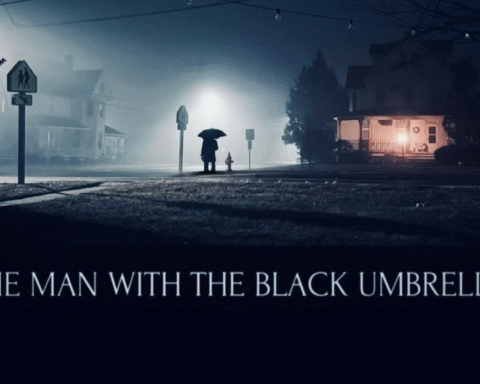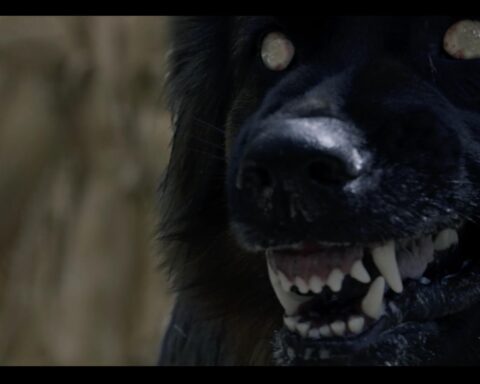The Menu, directed by Mark Mylod, is not merely a film about food; it is a layered, multifaceted exploration of the human condition, the nature of creativity, the pursuit of perfection, and the existential void that lies beneath the surface of modern consumer culture. The film’s narrative structure, which is divided into a series of courses that correspond to the progression of a lavish and increasingly surreal meal, serves as both a literal and metaphorical framework for the story. Each course is meticulously crafted, both within the film’s diegesis and in its narrative function, to evoke deeper questions about the relationship between art and commerce, creator and consumer, and the consequences of our desires.
From the very beginning, The Menu establishes itself as a film that defies simple categorization. It blends elements of horror, dark comedy, and social satire, creating a unique cinematic experience that is as intellectually stimulating as it is viscerally disturbing. The film’s setting—an isolated island that houses an exclusive restaurant where the world’s elite gather for a once-in-a-lifetime dining experience—serves as a microcosm for the broader societal issues the film seeks to explore. Through its characters, who each represent different facets of the cultural and economic elite, and its meticulous attention to the culinary arts, The Menu invites viewers to ponder the deeper meanings behind what we consume, both literally and metaphorically.
As we embark on this extended analysis of The Menu, we will dissect each course of the meal as it is presented in the film, exploring the culinary techniques, symbolic meanings, and philosophical underpinnings that make this film a complex and thought-provoking work of art. By the end, we will have uncovered the rich tapestry of themes that make The Menu a profound meditation on the nature of existence, the destructive pursuit of perfection, and the often-ignored consequences of our consumerist lifestyles.

First Course: The Amuse-Bouche – Setting the Stage for a Culinary Odyssey
The film begins with an invitation, a carefully curated selection of guests who are about to embark on a journey that will challenge their perceptions of food, art, and themselves. This initial gathering functions as the amuse-bouche of the film—a small, tantalizing introduction that hints at the complexity and depth of what is to come. The amuse-bouche, in culinary terms, is meant to awaken the palate and prepare it for the courses that follow, much like how the film’s opening scenes introduce the characters and setting in a way that prepares the audience for the thematic explorations ahead.
The guests are ferried to an exclusive island, where they will dine at the restaurant of the enigmatic and revered Chef Slowik, played by Ralph Fiennes. The island itself is a crucial element of the film’s mise en scène, representing both a physical and metaphorical isolation from the rest of the world. It is a place where the usual rules of society do not apply, and where the characters will be forced to confront their own complicity in the systems of power and privilege that have brought them there.
Each guest represents a different aspect of the elite: a food critic and her editor, a fading movie star, a wealthy couple who are regular patrons, a trio of tech bros, and a young couple with divergent interests in the meal they are about to consume. These characters are not just individuals but symbols of the various ways in which society consumes art, culture, and even people. They are all, in their own way, seeking validation through their presence at this exclusive event, and their interactions with each other and with the staff of the restaurant reveal the underlying power dynamics at play.
The amuse-bouche itself is a delicate, almost ethereal creation, a single bite that encapsulates the precision and artistry of the chef’s craft. It is a small, yet significant, gesture that sets the tone for the rest of the meal. The chef’s introduction of the dish is equally important, as it establishes his role not just as a creator of food, but as a manipulator of experiences. He is both the architect of the meal and the orchestrator of the evening’s events, and from this moment, it becomes clear that the guests are not just passive participants, but integral components of the chef’s grand design.
This first course, while seemingly simple, is imbued with layers of meaning. It serves as a commentary on the nature of art and the artist’s relationship with the audience. The amuse-bouche, like the opening scenes of the film, is a carefully constructed illusion, a glimpse of the artistry that lies ahead, but also a reminder that the art itself is inseparable from the context in which it is consumed. The chef’s presentation of the amuse-bouche is a performance, and the guests, whether they realize it or not, are already playing their roles in the unfolding drama.
Second Course: The First Dish – The Illusion of Purity
The second course in The Menu presents the guests with a dish that is deceptively simple: a salad composed of foraged greens, wild herbs, and edible flowers, arranged with meticulous care. This dish represents the idea of purity and simplicity in both food and life, but as with much of the film, there is a deeper, more complex meaning beneath the surface. The salad is a reflection of the guests’ desires to connect with something real, something authentic, in a world that is increasingly dominated by artifice and superficiality.
The film uses this course to explore the theme of authenticity, both in the culinary world and in society at large. The foraged ingredients are a nod to the growing trend of farm-to-table dining, where the emphasis is placed on sourcing local, organic, and sustainable ingredients. However, the film also critiques the ways in which this trend has been co-opted by the elite as a status symbol, rather than as a genuine commitment to sustainability or ethical consumption. The salad, while visually stunning and seemingly natural, is a carefully constructed illusion, designed to appeal to the guests’ desire for purity without challenging their comfort or sense of entitlement.
This course also serves as a metaphor for the broader societal obsession with purity and the ways in which this obsession is often used to obscure more complex and uncomfortable realities. The guests, who are accustomed to consuming the finest and most exclusive products, are eager to believe in the illusion of purity that the salad represents, even as they remain oblivious to the labor and exploitation that underlie its creation. The film uses this moment to highlight the disconnect between the idealized image of purity and the often messy, complicated reality that lies beneath it.
The chef’s monologue during this course further reinforces this theme, as he speaks about the origins of the ingredients and the careful attention to detail that went into their preparation. His words are both a celebration of the natural world and a critique of the ways in which it has been commodified and sanitized for the consumption of the elite. The salad, like the guests themselves, is a product of its environment, shaped by the forces of nature and society, but ultimately manipulated to serve the desires of those in power.
As the guests consume the salad, they are unknowingly participating in a ritual that reinforces their own privilege and detachment from the realities of the world around them. The film uses this course to explore the idea that the pursuit of purity, whether in food or in life, is often an illusion, a way of avoiding the complexities and contradictions that are inherent in the human experience.

Third Course: The Missing Bread – The Absence of Substance
The third course of the meal is perhaps one of the most provocative and thematically rich moments in The Menu. The guests are presented with an array of exquisite accompaniments—luxurious oils, artisanal butters, and rare salts—yet the central element, the bread itself, is conspicuously absent. This deliberate omission serves as a powerful metaphor for the emptiness and superficiality that often characterize the lives of the elite.
Bread, in its simplest form, is a symbol of sustenance, the most basic and essential of foods. It has historically been the staple of the common people, a symbol of life and nourishment. By withholding the bread, the chef is making a pointed statement about the guests and the culture they represent. The accompaniments, while luxurious and rare, are ultimately meaningless without the bread to anchor them. This course is a critique of a society that has lost sight of what is truly essential, where the pursuit of luxury and exclusivity has led to a hollowing out of substance.
The absence of bread also serves as a commentary on the nature of modern consumerism, where the focus is often on the trappings of luxury rather than the substance of what is being consumed. The guests, who have come to expect the finest of everything, are confronted with the uncomfortable reality that their desires have led them to a point where they are consuming nothingness. The chef’s decision to withhold the bread is not just a provocation; it is a challenge to the guests to recognize the emptiness of their pursuits.
This course also highlights the power dynamics at play between the chef and the guests. By withholding the bread, the chef asserts his control over the meal and, by extension, over the guests themselves. The guests, who are accustomed to getting what they want, are powerless in the face of the chef’s decision. This moment serves as a turning point in the film, where the true nature of the evening begins to reveal itself, and the guests start to realize that they are not just participants in a meal, but pawns in a larger, more sinister game.
The chef’s explanation of the course further deepens the thematic resonance of this moment. He speaks about the historical significance of bread and its role in society, contrasting it with the luxury items that the guests have been given. His words are both a critique of the guests’ detachment from the realities of life and a reflection on the ways in which food, like art, can be used to manipulate and control. The absence of bread is a metaphor for the absence of meaning in the lives of the guests, who have lost sight of what is truly important in their pursuit of status and prestige.
As the guests struggle to make sense of the missing bread, the film uses this course to explore the broader societal implications of a culture that prioritizes appearance over substance, luxury over necessity, and exclusivity over inclusivity. The missing bread is a powerful symbol of the emptiness that lies at the heart of the modern consumer experience, and the guests’ reactions to this course reveal their own complicity in sustaining this emptiness.
Fourth Course: The Fish Dish – The Pursuit of Perfection
The fourth course in The Menu presents the guests with a beautifully prepared fish dish, a culinary masterpiece that represents the pinnacle of the chef’s artistry. This course serves as a metaphor for the relentless pursuit of perfection that characterizes both the culinary world and the broader society. The fish, delicate and precise, is a symbol of the unattainable ideal that drives the chef and, by extension, the guests who have come to consume his creations.
The film uses this course to explore the darker side of creativity and ambition, where the desire for perfection becomes a destructive force. The chef’s obsession with creating the perfect dish is both a source of pride and a burden, as he is constantly striving to achieve something that is ultimately unattainable. The fish dish, with its intricate preparation and presentation, is a reflection of the chef’s inner turmoil, his recognition that the pursuit of perfection is a futile endeavor, as true perfection is an illusion, always just out of reach.
This course also serves as a commentary on the nature of artistry and the relationship between the artist and the audience. The chef, as an artist, is trapped in a paradox where his work is both a source of fulfillment and a source of suffering. The guests, who have come to expect nothing less than perfection, are complicit in this cycle, as their demands and expectations fuel the chef’s obsessive quest. The film uses this course to question the value of perfection and whether the sacrifices made in its pursuit are justified.
The chef’s monologue during this course reveals his inner conflict, as he speaks about the pressures of maintaining his reputation and the toll that this has taken on his life and psyche. He acknowledges the impossibility of achieving true perfection, yet he is unable to let go of his desire to create something that transcends the ordinary. The fish dish, while visually stunning and technically flawless, is ultimately a symbol of the unattainable, a reminder that no matter how hard we strive for perfection, it will always remain just out of reach.
The film uses this course to explore the broader implications of the pursuit of perfection in both art and life. The guests, who have been conditioned to expect the best of everything, are confronted with the realization that their desires have contributed to the chef’s torment, as he is forced to push himself to the brink in order to meet their expectations. The fish dish serves as a metaphor for the ways in which society places unrealistic demands on artists and creators, often at the expense of their well-being and humanity.
As the guests consume the fish dish, the film invites viewers to reflect on the nature of perfection and the costs associated with its pursuit. The chef’s obsession with perfection is both a reflection of his own inner demons and a commentary on the broader societal pressures that drive individuals to seek out the unattainable. The fish dish, like the other courses in the meal, is a carefully constructed illusion, a reminder that perfection is not only elusive but ultimately unattainable.

Fifth Course: The Meat Dish – The Violence of Creation
The fifth course of the meal marks a dramatic shift in tone, as the guests are presented with a meat dish that is both visually stunning and deeply unsettling. This course delves into the inherent violence of the creative process, the idea that creation and destruction are inextricably linked. The meat, often seen as a symbol of life and vitality, is here used to explore the darker aspects of consumption, where the act of eating becomes a confrontation with mortality and the primal forces of nature.
The film uses the preparation and presentation of this dish to explore the theme of sacrifice, both in the literal sense of the animal that has been slaughtered and in the metaphorical sense of the sacrifices made by the chef and his team in their pursuit of culinary excellence. The meat dish is a reminder that all creation comes at a cost, that life is sustained by the taking of life, and that the act of consumption is inherently tied to the act of destruction.
This course also serves as a commentary on the ethics of consumption and the often-hidden consequences of the choices we make as consumers. The guests, who have until this point been passive participants in the meal, are now forced to confront the reality of what it means to consume, to take life in order to sustain life. The film does not shy away from the visceral reality of eating meat, using it as a metaphor for the broader societal tendency to ignore the violence and exploitation that underpin our lifestyles.
The chef’s reflections during this course reveal his own ambivalence towards his craft, his recognition of the moral complexities involved in the act of creation, and his struggle to reconcile his love for cooking with the darker implications of his work. The meat dish is a symbol of the duality of creation, where beauty and brutality coexist, and where the act of creation is inseparable from the act of destruction.
The guests’ reactions to the meat dish further highlight the power dynamics at play in the meal. Some are visibly disturbed by the dish, while others remain indifferent, a reflection of their own detachment from the realities of life and death. The film uses this course to explore the ways in which society compartmentalizes and sanitizes the act of consumption, allowing us to enjoy the fruits of creation without confronting the violence that makes it possible.
As the guests consume the meat dish, the film invites viewers to reflect on the ethical implications of their own consumption habits and the ways in which we are all complicit in the cycle of creation and destruction. The meat dish serves as a reminder that all actions have consequences, and that the pursuit of pleasure and excess often comes at a cost.
Sixth Course: The Cheese Dish – The Decadence of Decay
As the meal progresses towards its conclusion, the sixth course introduces a cheese dish that symbolizes the theme of decadence and decay. Cheese, with its rich flavors and often pungent aroma, is a product of fermentation, a process that involves the controlled decay of milk. This course serves as a metaphor for the idea that all things, no matter how luxurious or refined, are subject to the forces of decay and entropy.
The film uses the cheese course to explore the concept of decadence, where excess and luxury become intertwined with decline and decay. The guests, who have indulged in a series of increasingly elaborate and luxurious dishes, are now faced with the realization that their pursuit of pleasure and excess has led them to a point of no return. The cheese, with its complex flavors that are the result of decay, serves as a reminder that even the most refined experiences are fleeting, subject to the inevitable passage of time.
The chef’s reflections during this course delve into the idea that the culinary arts, like all forms of art, are ultimately ephemeral, and that the pursuit of perfection and luxury is, in the end, a futile attempt to stave off the inevitable decay that awaits all things. The cheese dish is a metaphor for the tension between the desire for permanence and the reality of impermanence, and how this tension plays out in both the culinary world and in life more broadly.
This course also serves as a commentary on the nature of luxury and excess, where the pursuit of ever-greater pleasures ultimately leads to a kind of decadence that is inseparable from decay. The guests, who have been conditioned to seek out the finest and most exclusive experiences, are now faced with the reality that their desires have led them to a point of diminishing returns, where the pleasures they seek are increasingly elusive and fleeting.
The film uses the cheese course to explore the broader implications of a culture that prioritizes luxury and excess over substance and sustainability. The guests, who have indulged in a series of increasingly elaborate and luxurious dishes, are now confronted with the realization that their pursuit of pleasure and excess has led them to a point of no return, where the pleasures they seek are increasingly elusive and fleeting.
As the guests consume the cheese dish, the film invites viewers to reflect on the nature of decadence and the ways in which the pursuit of luxury and excess often leads to a kind of moral and existential decay. The cheese dish serves as a reminder that all things, no matter how refined or luxurious, are subject to the forces of decay and entropy, and that the pursuit of perfection and luxury is ultimately a futile endeavor.

Seventh Course: The Dessert – The Bitter Aftertaste of Excess
The final course of the meal, dessert, serves as the denouement of the film, where all the themes and ideas explored throughout the meal come to a head. Dessert, often seen as the sweet and indulgent conclusion to a meal, is here presented as a moment of reckoning, where the guests are forced to confront the consequences of their choices and their complicity in the system that has brought them to this point.
The dessert course in The Menu is a complex and multi-layered metaphor for the idea that all actions have consequences, and that the pursuit of pleasure and excess ultimately leads to a moment of reckoning. The film uses the dessert to explore the concept of closure, both in the context of the meal and in the broader sense of life and death. The diners, who have indulged in a series of increasingly complex and luxurious dishes, are now faced with the reality that their actions have led them to a point of no return.
The dessert, with its rich and indulgent flavors, serves as a reminder that all things, no matter how sweet or pleasurable, must come to an end, and that the pursuit of excess and luxury often leads to a bitter and inevitable conclusion. The guests, who have been conditioned to seek out the finest and most exclusive experiences, are now confronted with the reality that their desires have led them to a point of diminishing returns, where the pleasures they seek are increasingly elusive and fleeting.
The chef’s reflections during this course reveal his own sense of disillusionment with the pursuit of perfection and luxury, and his recognition that the guests, who have come to expect the best of everything, are ultimately complicit in the system that has led to their downfall. The dessert serves as a final, bitter reminder that all actions have consequences, and that the pursuit of pleasure and excess often comes at a cost.
As the guests consume the dessert, the film invites viewers to reflect on the nature of closure and the ways in which the pursuit of luxury and excess often leads to a kind of moral and existential decay. The dessert serves as a reminder that all things, no matter how refined or luxurious, are subject to the forces of decay and entropy, and that the pursuit of perfection and luxury is ultimately a futile endeavor.
Epilogue: The Empty Plates – A Meditation on Consumption and Consequence
The film’s conclusion, marked by the empty plates left behind by the guests, serves as a powerful metaphor for the emptiness and futility of their pursuits. The guests, who have consumed a meal of unparalleled luxury and complexity, are now left with nothing but the remnants of their excess. The empty plates are a symbol of the emptiness that lies at the heart of their lives, and the realization that their pursuit of pleasure and excess has ultimately led them to a point of no return.
The film uses the empty plates to explore the broader societal implications of a culture that prioritizes consumption and excess over substance and sustainability. The guests, who have indulged in a series of increasingly elaborate and luxurious dishes, are now confronted with the reality that their desires have led them to a point of diminishing returns, where the pleasures they seek are increasingly elusive and fleeting.
The empty plates also serve as a metaphor for the broader consequences of our consumerist lifestyles, where the pursuit of luxury and excess often leads to a kind of moral and existential decay. The film invites viewers to reflect on the nature of consumption and the ways in which our desires and choices have consequences, both for ourselves and for the world around us.
As the film draws to a close, the empty plates serve as a reminder that all things, no matter how refined or luxurious, are subject to the forces of decay and entropy, and that the pursuit of perfection and luxury is ultimately a futile endeavor. The film leaves viewers with a sense of unease and reflection, inviting them to consider the broader implications of their own consumption habits and the ways in which they contribute to the cycles of creation and destruction that underpin our society.

The Philosophical Underpinnings of The Menu
The Menu is a film that operates on multiple levels, blending dark comedy, suspense, and social commentary with a deep exploration of the culinary arts as a metaphor for the human condition. Through its meticulously crafted courses, the film delves into themes of consumption, creativity, perfection, and the inevitability of decay, offering a profound reflection on the nature of art, life, and the choices we make as individuals and as a society.
The film’s structure, with each course serving as a chapter in the unfolding narrative, allows for a nuanced exploration of the complex relationship between the creator and the consumer, and the power dynamics that underpin this relationship. The chef, as both a creator and a destroyer, embodies the dualities inherent in the creative process, where the pursuit of perfection is both a source of pride and a burden.
Ultimately, The Menu is a meditation on the futility of the pursuit of perfection and the often-destructive forces that drive us to seek out the unattainable. Through its exploration of the culinary world, the film offers a broader commentary on the nature of art, the ethics of consumption, and the human condition, inviting us to reflect on the choices we make and the consequences of those choices. The empty plates left behind at the end of the meal serve as a powerful reminder that in the pursuit of excess and luxury, we often lose sight of what is truly important, and that the quest for perfection is ultimately a hollow and unfulfilling endeavor.
The film’s conclusion, marked by the empty plates and the guests’ realization of the futility of their pursuits, serves as a poignant commentary on the nature of consumption and the ways in which our desires and choices have consequences, both for ourselves and for the world around us. The Menu leaves viewers with a sense of unease and reflection, inviting them to consider the broader implications of their own consumption habits and the ways in which they contribute to the cycles of creation and destruction that underpin our society.
Through its meticulous attention to detail, its exploration of complex themes, and its masterful blending of genres, The Menu stands as a powerful and thought-provoking film that challenges viewers to confront the deeper meanings behind what we consume and the consequences of our desires. It is a film that lingers long after the credits roll, a cinematic feast that leaves us questioning the nature of art, life, and the choices we make in our pursuit of the perfect experience.









